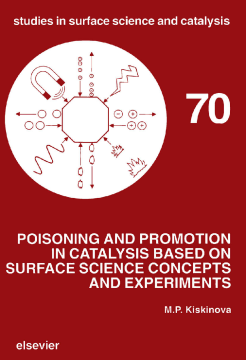
BOOK
Poisoning and Promotion in Catalysis based on Surface Science Concepts and Experiments
(1991)
Additional Information
Book Details
Abstract
The topics covered in this book include a variety of adsorption and model reaction studies on clean and modified single crystal metal surfaces obtained by means of properly selected surface sensitive techniques. The accent is on the revelation of the physics and chemistry involved in the effects of various modifiers on the adsorptive and reactivity properties of the surface with respect to different reactants.
In this book current information that contributes to the fundamental understanding of the effect of additives is summarized. Some of the additives act as promoters, others as poisons, in a number of important catalytic reactions. A description of single- and double-component systems has been obtained by using surface-sensitive techniques, particularly suited for this purpose. For the benefit of the reader, a short summary of the main surface science techniques has been given in Chapter 2.
Three general and interrelated topics are reviewed. The first concerns the interaction of electronegative (Cl, S, Se, C, N, O, P) and electropositive (alkali metals) atoms with metal surfaces (Chapter 4). The second topic covers the chemisorptive properties of metal surfaces modified by varying amounts of additives with respect to different reactants (CO, NO, N2, O2, H2, CO2, NH3, H2O and hydrocarbons) (Chapters 5 and 6). In particular the adsorption kinetics and energetics, and the electronic, structural and reactive properties of the coadsorbate systems are considered, whereby particular attention is given to recent surface science studies with well-characterized, single crystal, metal surfaces. In these chapters, special attention is paid to showing the contribution of different factors (the nature and adsorption state of the modifier and the coadsorbed molecule, the structure of the adsorbed layer, the type of interactions in the mixed overlayers, etc.) to the modifier effects. In the discussion of the third topic, model studies of several important catalytic reactions (Fischer-Tropsch synthesis, ammonia synthesis, CO oxidation, water-gas shift synthesis) on modified metal surfaces (Chapter 8) are considered.
The book will be particularly useful to scientists who are interested in adsorption phenomena, surface properties and catalysis. It should also prove invaluable to those addressing the questions of condensed matter (surfaces and interfaces), materials science (e.g. corrosion of metals) and electrochemistry.
...has well succeeded in presenting a unified discussion on the promotion and poisoning behaviour of the modified catalyst surfaces based on extensive data obtained from modern surface-sensitive techniques.
Bulletin of Electrochemistry
